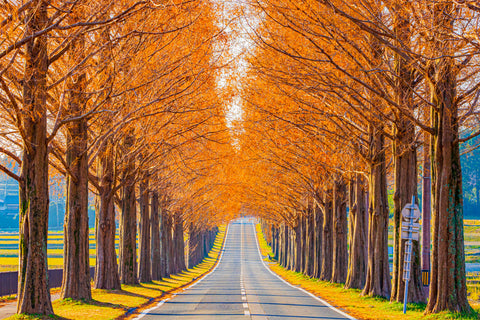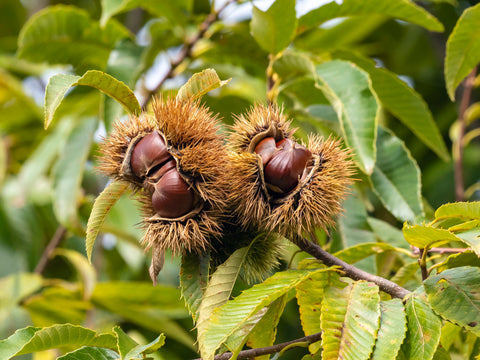A Brief Guide To Japanese Trees

Jump to:
Forests are at the heart of Japan's rich natural environment. In Japan, trees have long played an important role in everything from daily necessities to architecture and art. Japanese trees are a major tourist attraction, with thousands of people traveling from within Japan or coming from overseas to view cherry blossom trees in the spring, as well as Japanese maple trees resplendent in the autumn during the Koyo season. The Japanese people also have a strong spiritual feeling toward trees.
In this article, we shall examine the relationship between Japanese culture and trees, as well as take a look at some different types of Japanese trees, and their various characteristics and uses, which range from purely decorative to highly functional.
The Essential Link Between Japanese People And Trees

From a geographical perspective, as much as anything else, Japan has an essential relationship with trees. About two-thirds of Japan's land area is forested. The ratio of forested area to total land area is referred to as the forest coverage ratio, and Japan ranks third in the world after only Finland and Sweden in terms of this ratio. Furthermore, while most forests in Northern Europe are dominated by conifers, Japan's forests are characterized by the huge variety of trees found there.
Trees have long had a spiritual meaning for Japanese people. It was formerly believed that Japanese gods descended from trees, specific trees were worshipped and giant trees were lauded as ancestral deities. The tendency to worship a specific tree can be found in ancient Japanese classical literature, such as “Wamei Ruiju Sho.” Words appear like Mokurei and Mokutama, which incorporate the idea that trees are inhabited by souls.
Shimenawa are lengths of rice straw or hemp rope that are used in the Shinto religion for the purpose of ritual purification, and, even today, you can see Shimenawa rope with Shide paper streamers placed around the trunk of trees to indicate that trees are sacred and that Shinto gods dwell within. These sacred trees are given the name Shinboku. Wood is also the material of choice for religious buildings such as temples and shrines.
Japanese people have also long used wood as the main material in the buildings they live in as well, so in that sense, trees form the very foundation of Japanese life. See this article for more information about Japan’s use of wood.
Trees For Viewing
Viewing the blossoms of flowers from various Japanese trees every year is big business in Japan. A 2019 estimate found that approximately 63 million people traveled to and within Japan to see cherry blossoms, thus stimulating the travel, accommodation, and food/drink industries. Whereas cherry blossoms are the major draw, one should not forget plum blossom which blooms a little before cherry blossoms in spring, and the Japanese red maple that adorn the mountains during the Koyo season in the fall.
Japanese Cherry Trees

This cherry tree (Prunus serrulate) has been cross-bred to create multiple varieties of trees that blossom at slightly different times, thus elongating the cherry blossom season. The Japanese cherry tree grows to approximately 12 meters and is characterized by its bright pink oval-shaped leaves. Its popularity is clear from the fact that tens of millions of Instagram photos are posted every year during Sakura season. For information on viewing cherry blossoms in Tokyo, you can check out this blog post.
Japanese Plum Tree

Whereas the word Ume means plum in English, this tree is somewhat confusingly referred to by the English title of Japanese apricot. It is a deciduous tree that produces both pink and yellow flowers. The blossoming of these trees, which grow to around 10-15 meters in height, is seen by many as a welcome sign of the end of winter and, as a precursor of spring, creates anticipation for the cherry blossoms to come.
Japanese Red Maple

The stunning red blossom on this tree, which is called Momiji in Japanese, causes huge crowds to gather for the Koyo season in autumn in the same way that many do in spring for cherry blossoms, and vast landscapes of red blossoms over a mountainside is one of the iconic images of Japan. The maple tree grows slowly, at the rate of 30-40 cm per year, but can grow to approximately 10 meters in height. They also have the symbolic meaning of welcoming in the autumn months after the stifling heat of summer.
Japanese Red Pine

This tree, which grows to around 20-35 meters, is an ornamental tree often found in Japanese gardens. Its name comes not from the color of its leaves but from its orange-red bark. It has green needle-like leaves that are approximately 8-12 cm in length. In addition to its ornamental qualities, its trunk is rich in resin, from which rosin and turpentine can be extracted. Its wood also has natural anti-corrosion and anti-mildew properties, enabling the production of natural preservatives and natural wood anti-mold agents. Essential oils can also be extracted from its leaves.
Trees Used For Making Things
Zelkova

Although not famed for its blossom, the Zelkova might have also appeared in the previous category of trees for viewing, as it has ornamental uses in that it is often used as a bonsai plant.
Despite being used as miniature tree art, the tree itself is capable of reaching the lofty heights of over 30 meters with a circumference of approximately 8 meters, Despite its ornamental use as bonsai, the tree has many functional uses, and its wood is often used in traditional furniture, and for shrine and temple architecture, being prized by craftsmen for its durability, flexibility, and the attractive qualities of its grain.
Japanese Cedar

Although its pollen is the bane of many hay fever and other pollen allergy sufferers throughout Japan every year, this large evergreen tree, which towers to the lofty heights of approximately 70 meters, has a number of essential uses. Firstly, the larvae of many of the native moth species of Japan feed on it, giving it a vital role within the ecosystem. Although used for house building in the medieval era, it later fell out of favor for imported wood from Canada and Finland. Recently, however, it has had something of a renaissance in furniture-making, where the flaws in its wood, caused by its knots and soft texture, give each work a truly individual design. The tree is characterized by its dark red-brown peeling bark and green needles.
Japanese Chestnut Tree

The Japanese chestnut tree (or Castanea crenata) is a small-to medium-sized deciduous tree. Apart from its obvious benefit in producing sweet, delicious chestnuts, which you can often find roasting by the roadside in Japan, the Urushi of this tree, which normally grows 10 to 15 meters in height but can be much taller, is also an important source of the lacquer used in the Japanese craft of lacquerware (see this article for more information on lacquerware). A famous chestnut tree, standing approximately 23 meters in height, near Komyoji Temple and Mt. Kimino in Kyoto Prefecture, is said to be around 2,000 years old.
Gingko Trees

This long-branched tree, with its fan-shaped leaves, can grow to approximately 35 meters in height, and it has a number of features that make it a very useful tree indeed. Wood obtained from Gingko trees, which is fire-resistant and slow to decay, is used for making such items as chessboards, furniture, and carvings, as well as casks for making Nihonshu, that is to say, Japanese sake. When the ginkgo tree sheds its leaves, the fallen leaves can be used to make insecticides and fertilizer. Although originally from China, ginkgo nuts have been enjoyed as a side dish in Japan since the Edo era (1600-1867). If this was not enough, the leaves of the Gingko tree have also been found to have many medicinal benefits. It is claimed that it can be used to keep your memory sharp, and it is used in traditional Chinese and homeopathic medicine for blood thinning and medicines for treating circulatory illness, due to the flavonoid glycosides and ginkgolides it contains.
Hinoki Cypress

Last but not least is the Hinoki Cypress tree, otherwise called the Japanese Cypress, which is native to the central areas of Japan. It has red-brown bark and green leaves with cones that are approximately 2-3 cm long. The wood of the Cypress tree has a beautiful luster and aroma, which accounts for its popularity as a material for items such as sculptures, chopping boards, walls, and flooring.
It is also extensively used for religious buildings, such as palaces, temples, and shrines, where its superior rot-resistant qualities make it a popular choice. Well-known examples of religious buildings that use Hinoki Cypress are Osaka Castle and Horyuji Temple.
Japanese Trees - The Heart Of Japan
As we have seen in this post, Japan is not only densely populated with trees, but there is a huge variety for us to explore and enjoy, and trees play an essential part in Japanese culture, tourism, spirituality, and lifestyle.
Do you have a favorite type of Japanese tree? What do you like about it? We’d love to hear your thoughts in the comments.

2 comments
Hi Marianne,
Thank you for your comment!
Based on your description, here are three guesses: Nanakamado (Japanese Rowan), Aohada (Ilex macropoda), or Zumi (Malus toringo).
I hope one of them is the tree you’re thinking of!
Daitool,
Seeking name of Japanese tree that grows white / ivory blossoms atop the branches; all the flowers are visible OVER the green leaves…
Marianne SELWYN,